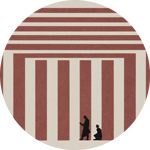The Tartarian Mythos
From the beginning, the Western myth has been that of an expulsion. Before Adam sinned, he dwelt in the Garden with Eve, at peace with the animals, in full communication with God and nature, enjoying the fruits of the Tree of Knowledge and the Tree of Life. Then, having been deceived by a serpent, he was cast out into the world, his body stained with shame, his heart filled with fear, condemned to labor pains and mortality. We have inherited this image, this story, and we still tell it, even while in many ways we’ve forgotten its meaning.
In the same way, the Tartarian conspiracy theory begins with a kind of expulsion. Proponents will tell you that this world you live in now was not always so. That at some point in the unrecorded past, Tartaria ruled the Earth, its engineers constructing magnificent buildings and its artists producing dazzling frescos. Even now, as you read these words, there are hidden chambers filled with paintings and statues, vaults of gold and archives of secret knowledge. But something went wrong, there came a series of cataclysms, “mud floods” which buried much of their cities below the level of the streets, and finally the civilization was destroyed, and the great knowledge was lost to history.
All that remains are scattered clues to what was taken from us, and the unfinished monuments and buildings which bear witness to the existence of a once thriving civilization which we never really knew.
What’s fascinating about this narrative is how it seems to serve precisely the opposite purpose as its obvious formulation. On the one hand, it’s an expulsion myth, like that of the Garden of Eden—the story of how we lost a state of blissful innocence. But the message it appears to communicate is anything but that. It seems more like an inverse expulsion myth—telling us not how we once dwelt in a garden, but how we now dwell in a world of artifice. Not how our ancestors were expelled from a world of unity, but how we ourselves were expelled from a world of multiplicity, of splendor and beauty, of cities and skyscrapers that reflected not just the human spirit but the divine essence as well, that once contained all the knowledge that ever existed, and more, much more than that.
The Myth
What makes Tartaria particularly insidious is how it functions. Believers conveniently exile the loss of an ideal civilization to some remote, shadowy past—a neat trick that absolves them from the messy work of confronting their own complicity in the present hellscape. It’s far easier to believe that everything beautiful was taken from us by shadowy forces than to acknowledge that we’re all implicated in constructing a world that fails to accommodate human spirit.
So really it’s a story not about innocence but about loss, about a Golden Age—the loss of a world of elaborate machinery, splendid architecture, cities of astonishing design—a world that we ourselves never really knew. To the Tartarian believer, the world we know is not the world of true history but a false world, a world of simulation and shadows, an utterly degraded and reduced version of what could have been. Like the myth of Atlantis, this story has a kind of nostalgic sadness. But it carries with it more than a little of the cruelty of those who tell it. It’s an attitude towards the world which is suffused with the bitterness of disappointment, with the hatred of compromise, of adaptation, of survival.
It’s important to see that the Tartarian myth operates as a twofold delusion. On one hand, it insists that the civilization we live in now can’t possibly have been built by its nominal ancestors, that it must have been constructed by someone else, and at a much later date. (Hence the suspicious basement levels and raised street floors of so many of our old buildings.) On the other hand, it insists that our own civilization is a diminished and degraded version of some previous and more glorious age. So the conspiracy actually is twofold—not just one age supplanting another, but two conspiracies, one to construct a simulated world and the other to conceal the truth about what was lost.
Of course the first conspiracy is absurd on the face of it: that our historical architecture must have been built by some advanced civilization rather than known architects? This collapses under minimal scrutiny. The documented evolution of architectural styles, construction techniques, and the well-preserved records of these buildings’ actual creation make this fantasy impossible to maintain without willful ignorance. But the second conspiracy is truly monstrous, and reveals how we have lost something far more profound and far-reaching than any set of architectural innovations. For what was lost was not beauty itself but the capacity for community – not the ability to make beautiful things but the ability to make places in which community could flourish.
The Function of Delusion
What the Tartarian believer has actually lost is the knowledge not of a vanished civilization but of a lost way of organizing social space, of how to build a city as a nexus of communication, a network of streets designed not only for the circulation of traffic and commerce but for the circulation of people, of how to create public spaces that foster sociability and spontaneous interaction, of how to incorporate into the structure of a city certain patterns of use that have in effect been deleted from the modern urban landscape.
It’s possible, for example, to look at certain 19th century department stores, grand old hotels, or railway stations and to recognize certain features of design that are missing from contemporary architecture – the presence of beautiful details, the use of ornament in such a way as to express function, the incorporation of scale differences and changes of level. It’s not that these things can’t be built today, or that modern architects aren’t capable of producing buildings of great beauty. It’s that we’ve lost the specific tradition of designing public spaces with a view to the social life of the city—so that we can no longer build cities which have an organic relation to the kind of use they get, which contain within them a pattern of movement, a net of social relations, a way of life. In fact, we’ve lost the capacity not just to build them but even to imagine what such cities would be like.
The Tartarian believer, unlike what they might claim, isn’t merely lamenting lost technology or grand architecture. What they’re truly mourning—without realizing it—is the absence of meaning and connection in contemporary spaces. Their fixation on lost civilizations is a displaced denial that our devotion to capital has erased our capacity to create environments that foster human spirit.
What’s more, we’ve lost not only the desire to build shared spaces but also to build private spaces—of how to design buildings which enhance the quality of domestic life. We’ve come to live in a world of boxes, not buildings, where the needs of manufacturing and commerce have determined the shape of houses and apartments. The physical quality of space has been reduced to a blunt instrument of class stratification, where affluence determines whether your alienation comes with marble countertops or laminate. Both kinds of box have lost any sense of genuine humanity, any feel for domestic scale, any organic relation to the life that is lived within it.
The most important thing that was lost, however, was not so much will to build beautiful things, but building as a way of understanding beauty itself. Beauty as the expression of a way of organizing space, of creating a nexus of communication, of gathering a community together. Today we’ve come to understand beauty as purely a matter of personal taste, as something completely subjective and individual, which means we no longer even have a common language to talk about it—much less a common understanding. It’s this loss of a language with which to discuss the nature of places and things, this loss of the sense that beauty could ever have anything to do with community, that the Tartarian conspiracy serves to conceal.
Abdication
In other words, the Tartarian myth is a way of avoiding the implications of how we ourselves and the systems we construct have changed the world, and of concealing from us the fact that we live in a world without community. It’s a way of evading the problem of how we can create community in a world which is, in so many ways, hostile to it. It’s a way of preserving the fiction that there are other worlds possible, without our having to struggle to make them real. Above all, it’s a way of giving up hope—of blaming the loss of community on an event in the remote past, instead of acknowledging that it’s something we have to take responsibility for today.
In the end, then, the Tartarian myth is a story about why we don’t have to work for what we want. It’s a convenient fiction which allows us to feel hopeless without having to bother with the effort of getting involved in politics, of organizing ourselves as a force against the system that keeps us isolated, atomized, and alienated. As long as we can blame the loss of community on some calamity co-opted by evil forces, we don’t have to take responsibility for changing the world. It’s easier to believe that everything was taken from us by someone else than to acknowledge that we’re all implicated, through our own daily choices and habits of thought, in constructing a world that can’t seem to accommodate us.
The Tartarian myth is ultimately just another opiate for the politically incoherent—a TikTok rabbit hole that manages the impressive feat of being simultaneously paranoid and complacent. What sets it apart is not its absurdity but the historical moment into which it’s been born - one marked by profound institutional distrust, the collapse of shared epistemological frameworks, and a digital landscape where the pursuit of hidden knowledge becomes its own form of meaning-making. The conspiracy thrives precisely because it offers a simplified explanation for what has been lost when the real culprits—capital, technocracy, and our own passive complicity—are far more complex to confront.
The true conspiracy isn’t buried in mud floods but in broad daylight: the systemic destruction of our collective capacity to imagine and build a world worth inhabiting. And unlike Tartaria, this plot leaves fingerprints everywhere—on zoning laws, on developer profits, on every NIMBY petition, on the crushing weight of student debt that ensures architects design banking headquarters instead of public housing. That’s the only kind of “conspiracy theory” worth any real historian’s attention—the plot to put humanity itself into the past, to replace it with a world of financialized markets, and the price we have to pay to get out of it.
Never before have we been so aware of our own power to destroy the Earth, or of the precariousness of our own survival. Never before have we been so isolated, atomized, and alienated. Never before have we been so hungry for meaning. And never before have we had such an advanced technology with which to try and put things right.




